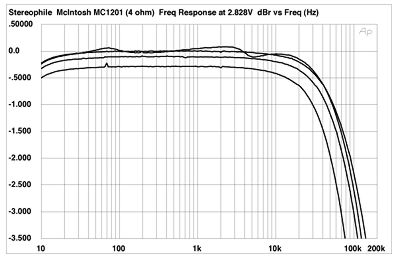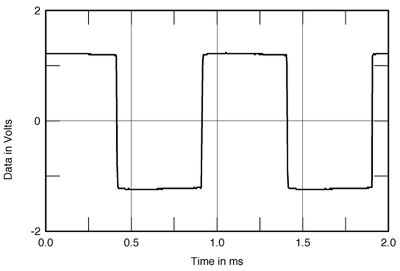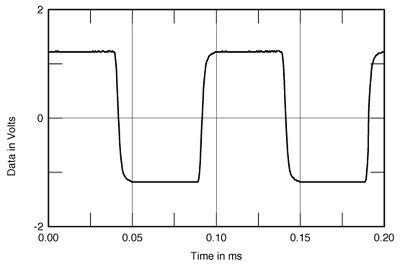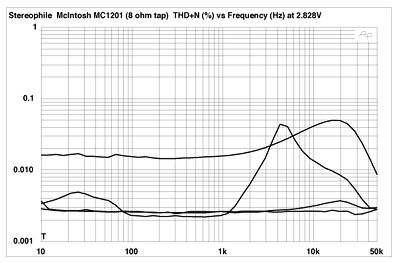| Columns Retired Columns & Blogs |
McIntosh MC1201 monoblock power amplifier Measurements
Sidebar 3: Measurements
My usual practice is to subject amplifiers to a one-hour preconditioning period at 1/3 power. In the case of the humongous McIntosh MC1201, that meant 400W into 8 ohms from its 8 ohm output transformer tap. (One-third power is chosen because this maximally thermally stresses an amplifier with a class-B output stage.) To my surprise, the MC1201 shut down after 40 minutes or so, its heatsinks too hot to touch. This happened again during the testing. Each time, the MC1201 could be reset once it had cooled down, but this suggests that the amplifier is not recommended for continuous operation at very high output levels. (The Grateful Dead were supposed to have used powerful McIntosh amplifiers for their sophisticated and high-quality "wall of sound" PA system in the 1970s.)
The MC1201 was noninverting from both its single-ended and balanced inputs (the XLR for the latter is wired with pin 2 "hot"), while its input impedance at 1kHz was a low 8.6k ohms unbalanced, 17k ohms balanced. The voltage gain into 8 ohms varied as expected, according to which output transformer tap and input were used. The single-ended figures were 32.1dB, 28.1dB, and 25.9dB into 8, 4, and 2 ohms, respectively. The balanced figures were all 6dB lower, which will be on the low side for some preamplifiers.
The output impedance also varied according to the output tap used, and proved difficult to accurately assess due to the output voltage's tendency to drift a bit in the unloaded condition. But as best I could tell, the midband impedance was 0.28 ohm, 0.2 ohm, and 0.175 ohm from the 8, 4, and 2 ohm outputs, respectively, rising a little at 20kHz. This is pretty good for an amplifier using an output transformer. As a result, the modification of the MC1201's response due to interaction with the manner in which the partnering loudspeaker's impedance varies with frequency will be quite small. This can be seen in fig.1, which shows the MC1201's frequency response assessed from the 4 ohm tap. As expected, the variation with our simulated loudspeaker load was less from the 2 ohm tap, greater (±0.25dB) from the 8 ohm tap (neither shown).

Fig.1 McIntosh MC1201, 4 ohm tap, frequency response at (from top to bottom at 2kHz): 2.83V into dummy loudspeaker load, 1W into 8 ohms, 2W into 4 ohms, and 4W into 2 ohms (0.5dB/vertical div.).
Even though it uses an output transformer, the McIntosh's reproduction of a small-signal 1kHz squarewave (fig.2) was perfect, with no leading-edge ringing and a negligible downward slope to the waveform tops and bottoms. The 10kHz waveform (fig.3) was also superb, with just a slight increase in the leading-edge risetime associated with the ultrasonic rolloff seen in fig.1.

Fig.2 McIntosh MC1201, small-signal 1kHz squarewave into 8 ohms.

Fig.3 McIntosh MC1201, small-signal 10kHz squarewave into 8 ohms.
In general, the MC1201's THD level was very low, provided the output transformer tap was approximately matched to the load. But as can be seen from fig.4, when the load is significantly below the tap rating, there is an increase in distortion, particularly at high frequencies (though to what is still a low level).

Fig.4 McIntosh MC1201, 8 ohm tap, THD+noise (%) vs frequency at (from top to bottom at 4kHz): 2.83V into simulated loudspeaker load, 4W into 2 ohms, 2W into 4 ohms, and 1W into 8 ohms.
- Log in or register to post comments




































